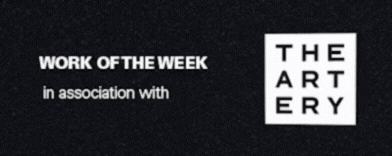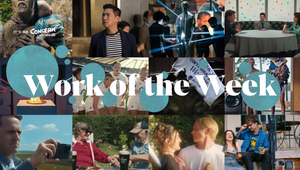
Work of the Week 09/05/25

Heineken – Trust Bars
Chosen by Sunna Coleman, reporter, Asia
I have spoken to countless advertising experts in the Asian market and they all stress one thing: to land an idea in Asia, you need to truly understand cultural nuances. And Heineken's 'Trust Bars' in Korea does exactly that.
Noting that, due to time differences and high labour costs, all pubs in the country are closed when UEFA Champions League matches are aired, Heineken found a way to keep them open. Taking Korea's unique culture of high social trust and familiarity with technology, Heineken introduced 'Trust Bars' across Seoul – where football fans can gather after hours to enjoy the game and are entrusted with paying for and pouring themselves their own fresh pint using a self-service system.
An idea that could only work in a country such as Korea. Brilliant.
Cocogun – The AM Dash

Chosen by Zhenya Tsenzharyk, UK editor
I love a good dash when writing (and think about this meme often) so it was pretty annoying to see the em-dash's good reputation get dragged all over the place thanks to ChatGPT and people unfamiliar with the versatility of this symbol. Writing belongs to people, not machines, and we must protect our right to add rhythm, emphasis, and meaning to sentences in whatever way we see fit. ‘The Am Dash’ from agency Cocogun is a new punctuation mark giving writers a way to say that a human was involved in the writing; a way to leave a mark that AI can’t reproduce, and to fight what the agency sees as the move to “Speed over quality. Efficiency over eloquence. Slop over soul.” Completely uncommercial, it’s available via two new, tailored typefaces: Times New Human and Areal, available to download and use alongside custom fonts. Not only is it a clever initiative, it's also presented with style – what more can we ask for?
Coca-Cola – We All Understand Coca-Cola
Chosen by April Summers, North America features lead
As someone who has been studying a second language for the last few years, this work really spoke to me. Because when you are attempting to follow a conversation in a foreign language, any vaguely familiar words or phrases are greatly valued. And recognising a brand name like ‘Coca-Cola’ is very exciting. It makes the world feel smaller, like whoever you are speaking to hasn’t lived quite such a different life to you, despite the cultural differences.
Tapping into the power of Coca-Cola as a symbol of connection, this campaign illustrates the brand’s iconicity by telling the stories of people who overcame language barriers to share a moment over a Coke. Featured languages include Spanish, French and German (written left to right) alongside Dhivehi, Sindhi and Urdu (written right to left). It’s thoughtful, grounded in reality, and the design is striking – no notes.
Life360 – I Think of You (Dying)
Chosen by Alex Reeves, managing editor, EMEA
To love is to suffer. That’s the truth at the heart of Life360’s product – allowing people the piece of mind of knowing that the people they care about are safe. It’s also the truth at the heart of this gorgeous campaign by ALTO. But the team hasn't taken the more obvious, po-faced route. Focusing on a more ridiculous tone, exaggerating the worries a mother has about her daughter, the musical film directed by Steve Ayson and Feral Child takes a social-first approach, considering the kind of humour that is more likely to be shared on TikTok. Soundtracked by songwriter Nick Lutsko, who is most notable for his work with the cult animated series ‘Ren & Stimpy’, it’s a musical romp. A bit of fun about a serious subject, made with care.
Chicago Hearing Society and Rakish Entertainment – Caption with Intention
Chosen by Zara Naseer, EMEA reporter
Imagine if every show you’d ever watched was monotone. Every line, flat and dry. For decades, that’s pretty much been the reality for Deaf audiences who rely on captions.
Traditional captions, which have essentially remained the same since the ‘70s, are riddled with shortcomings: they don’t convey tone, pace, volume, or even person speaking. So FCB Chicago, in close partnership with the Chicago Hearing Society (CHS) and core creative partner Rakish Entertainment, has launched Caption with Intention to demolish these major barriers to audience understanding and enjoyment.
Built with and for the Deaf community, the stunning design system uses colour to denote who’s speaking, as well as animation and typography to match their pace and intonation. It’s open source and freely available for adoption by studios, production companies, and streaming platforms worldwide.
There’s so much room for innovation in this sphere, and I can’t wait to see what else this inspires.
Aeroméxico - Aeromexicanos
Chosen by Ben Conway, Americas reporter
Mexican luchadores are renowned for their high-flying, audacious acrobatics – so who better to team up with Mexican airline Aeroméxico? Ogilvy Mexico helped turn the gravity-defying moves of Mexican wrestlers into a symbol of national pride, and surprised luchador Barack with his first-ever flight in the process. To do this, the agency created a formula that converted his ‘flight hours’ – his time spent airborne during matches – into air miles for a trip to Colombia.
The film itself also stars wrestling icons Redimido, Tigre Blanco and Bandido, and treats the lucha libre artform with style, passion and authenticity. The slo-mo shots of the wrestlers soaring off the turnbuckle are like something from a nature documentary, and the connection between the brand, Barack’s personal story and one of Mexico’s greatest traditions is both synergistic and artfully executed.
SIXT - SIXT hilft weiter

Chosen by Aysun Bora, Germany reporter
Oh boy, watching Friedrich Merz lose his first chancellor election in the German parliament was like watching a car crash in real time. At least he made it at his second attempt. But this historic failure will not be forgotten any time soon. What is bad for the German government, is good for business it seems. Jung von Matt managed to use this political showdown in their most recent campaign for car rental company SIXT and made many Germans laugh in schadenfreude.
For anyone who is not familiar with the German term, schadenfreude is the pleasure derived from someone else’s downfall, inherently summarising what I felt when I saw this campaign. If you need more background information on what I personally call the “German Game of Thrones” read the article to find out more. The campaign is hilarious and cheeky. It is exactly what we needed to see after the public disaster.
German Federal Foreign Office - The Keys to the Freedom
Chosen by Aysun Bora, Germany reporter
Today is the 80th anniversary of Europe’s liberation and the end of the Nazi regime. A big day for Europe and the world but an even bigger one for Germans. Cult director Wim Wenders takes his audience on a personal journey and also tells the story of the Nazi’s surrender. In the 4-minute piece, Wim says that “peace cannot be taken for granted”. The film is quite topical since diplomatic peace talks with Russia regarding its occupation in Ukraine are still unsuccessful. For context, the German parliament voted on an historic change to the country's debt borrowing rules, freeing up €500bn (£420bn) for infrastructure and defence. This also includes military aid to Ukraine, which is set at €4 billion (£4.4 bn) for 2025. With his thoughtful piece for the Federal Foreign Office, Wim wisely reviews historic lessons from the past and throws them forward. A cinematic, commemorative film that makes you think.
Canadian Blood Services - Who’s Saving Who?
Chosen by Jordan Won Neufeldt, Canada reporter
Campaigns promoting acts of selflessness are always fighting an uphill battle from the get-go. Unfortunately, there’s a dire need for generosity in the world, all while many, many organisations are fighting for a piece of the attention pie, so inevitably, it takes a truly exceptional effort to stand out, no matter how noble a cause might be.
Rising to the challenge this week is Canadian Blood Services’ latest campaign, created in partnership with Toronto-based agency Diamond. Subverting category expectations by shifting the spotlight off the patients to the donors themselves, this new national brand platform is headlined by a visually-striking James Michael Chiang-directed spot (Scouts Honour) titled ‘I Am Here to Save You’. Depicting giving blood as an opportunity for self-discovery, enrichment and fulfillment, the work features recipients talking straight to the audience, their strong dialogue serving as a compelling and memorable motivator for Canadians to choose this path in the pursuit of good.
Amnesty International – Truth Is Our Weapon

Chosen by Olivia Atkins, EMEA editor
This campaign stood out, because it’s a reminder of how powerful and effective print can still be when done right. ‘The Power of Truth’ by Dentsu Creative Italy for Amnesty International is striking in its simplicity – it’s one strong visual idea that’s executed with clarity and emotional impact.
In an industry that often overcomplicates its messages, this campaign pulls focus with minimalism and purpose. It conveys an important and often overlooked message: the life-risking work of photojournalists and the crucial role press freedom plays in exposing injustice.
By flipping the visual narrative – and having perpetrators halting in fear of the camera and not in the face of weapons – it delivers a fresh and provocative perspective, a rare feat in advertising today. It also subtly reasserts print media as a truth-telling force in a digital-saturated age. This is thoughtful, necessary work that lingers long after you’ve turned the page.
Subway - Meatbäll Marinara

Chosen by Addison Capper, managing editor, Americas
If there are three things in life whose structural integrity I care deeply about, it’s the buildings I stand in, the furniture I sit on, and the sandwiches I eat. Two of those collided in ballsy fashion this week as Subway on Oxford Street in London attempted to hijack IKEA's arrival as a neighbour. Saatchi & Saatchi London, Fabric and Taylor Herring collaborated on activation that saw free 6-inch 'Meatbäll' Marinara subs handed out to shoppers. But the real joy? The beautifully illustrated, flat-pack style instructions for the construction and demolition of the sandwich in question. All of which begs the question: isn't a legit IKEA x Subway meatball collab sandwich the natural next step for this campaign?
Telstra - Into Art

Chosen by Tom Loudon, AUNZ reporter
Telstra's ‘Into Art’ is an unconventional initiative transforming three art-averse Australians into hyper-realistic sculptures, thanks to renowned artist Sam Jinks.
Created with +61 and Bear Meets Eagle On Fire, the campaign sees real people -- Bradley, Midori, and Wally -- immortalised in silicone, resin, and human hair at Melbourne's Ian Potter Centre, challenging perceptions about art accessibility.
The campaign is a masterclass in brand-funded cultural initiatives. The choice of hyper-realistic sculptures rather than traditional portraiture creates immediate intrigue, while symbolising the ‘art is everywhere’ message.
Having the subjects narrate their own audio tour is a particularly clever touch, making high art feel approachable through authentic, everyday commentary. The campaign's long-term impact will depend on whether it drives sustained engagement beyond the initial novelty.
The free merchandise is a smart nudge towards ongoing participation. When corporate art sponsorships often feel transactional, ‘Into Art’ refreshingly puts artistic integrity and audience experience first – a model others should watch closely.















